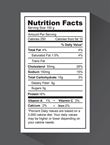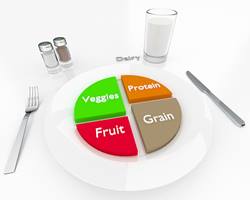Kids who are overweight or obese are usually eating more calories than their body needs. When excess calories are a concern, it is most often caused by frequent consumption of sugary beverages, high fat foods, large portions, or "junk" foods. To keep kids from eating too many calories, addressing portion sizes can be a good place to start.
Typical portion sizes have ballooned over time
Over the past 20 years, portion sizes have grown tremendously. These growing portions sizes are distorting our view on what a "normal" portion really is. With restaurants offering these gigantic sized meals, it can be challenging to know how much your child should be eating. When we do receive these "normal" portion sizes at restaurants, we often feel like we are getting ripped-off or sometimes we order additional food to supplement what is "missing."
In this super-sized age, are we teaching our kids that "bigger is better" when it comes to food? Remember, with this increase in meal size, the overall calories increase, and unfortunately so will our kid's waist size.
You may be wondering what the difference between portion size and serving size is.
- Portion size is the amount of food you choose to eat at one time.
- Serving size is the measured amount of food or drink, such as the one indicated on the nutrition facts label.
Knowing what a serving size is of your food can help prevent portion distortion.
Here are some ways to prevent portion distortion and keep portions in check.
1. Reduce plate size. Start with reducing the dinner plate size for the entire family. According to a research published by the journal Pediatrics, children who used larger plates served themselves bigger portions, which ultimately led to increased caloric intake. The tip here is to use smaller plates and serve your children the appropriate portions for their age.
 2. Check the nutrition facts label for serving sizes. This is where we get the reality check. The nutrition facts label provides consumers with the recommended serving size of that food. During snack time, check the serving size of their favorite foods. Provide them with no more than what the serving size indicates.
2. Check the nutrition facts label for serving sizes. This is where we get the reality check. The nutrition facts label provides consumers with the recommended serving size of that food. During snack time, check the serving size of their favorite foods. Provide them with no more than what the serving size indicates.
3. Listen to hunger cues. Encourage kids to pay more attention to their hunger and fullness cues. If children eat when they are not hungry or overfill their stomachs, they are more likely to consume excess calories throughout the day, which could lead to weight gain. Offer age-appropriate portions and discourage kids from eating everything on their plate.
4. Slow down. Most people eat fast. Very fast. We rarely take the time to enjoy and savor every bite of food. We blink and our food is gone. Kids learn by what is happening around them. If the entire family is always rushing through dinner, they are more likely to do the same. Slowing down can help kids become more mindful eaters, which unknowingly can lead to them consuming fewer calories. Start off by reducing distractions such as T.V. or cellphones and sitting together at the dinner table.
5. Estimate portions. Especially while out for dinner it can be challenging to watch portion sizes. Using objects or even an adult-size hand can help keep the amount of food on your kid's plate in check.
Here are some ways to estimate portions:
- Deck of cards or palm of hand = 2-3 ounces of meat
- CD case = one slice of bread
- Baseball or fist of hand= 1 cup of raw vegetables
- Tennis ball = ½ cup of ice cream or fresh fruit
- 4 dice = 1.5 ounce of cheese
- Computer mouse = baked potato
- One handful = 1 ounce of nuts

- Two handouts = 1 ounce of chips
6. Use MyPlate as a guide. The U.S. Department of Agriculture (USDA) created an easy-to-follow food guide, MyPlate, to help parents make smart meal choices. This colorful kid-friendly plate includes separate sections for each food group (vegetables, dairy, protein, grains, and fruit). Each section tells us how much of that food group to add to the meal plate. MyPlate indicates that ½ our plate should be made up of fruits and vegetables, ¼ grains, and ¼ protein. Try following the MyPlate at home to add some variety.










